
经典和现代数学物理方法 陆振球编著 上海科学技术出版社
书 经典和现代数学物理方法 陆振球 编著 上 海 科 学 技 术 出 版 社
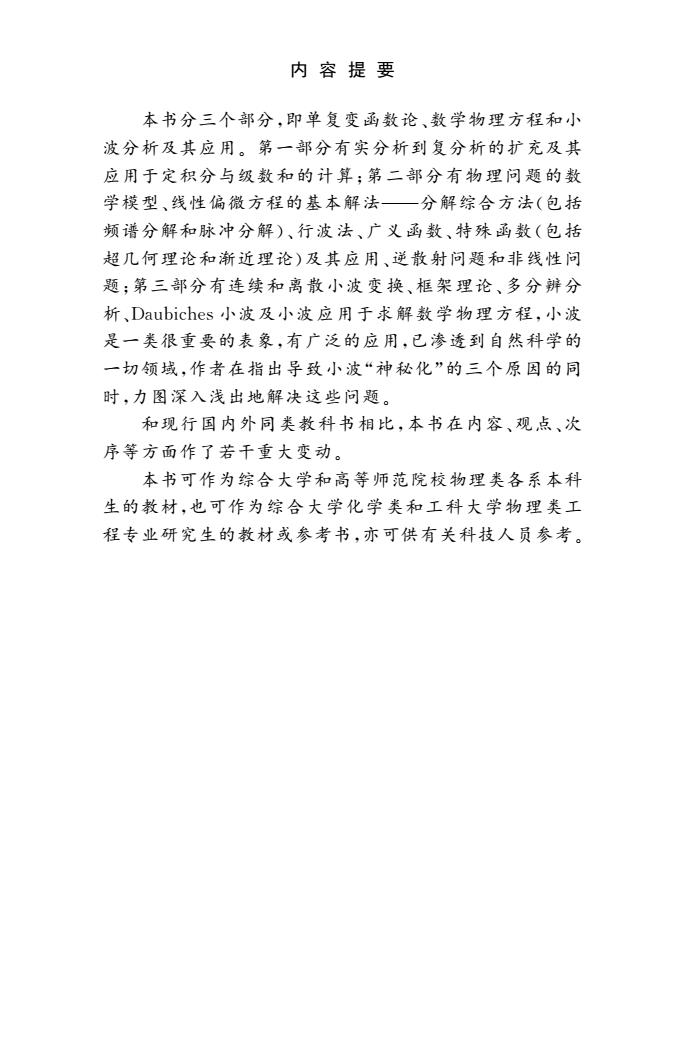
内容提要 本书分三个部分,即单复变函数论、数学物理方程和小 波分析及其应用。第一部分有实分析到复分析的扩充及其 应用于定积分与级数和的计算:第二部分有物理问题的数 学模型、线性偏微方程的基本解法—分解综合方法(包括 频谱分解和脉冲分解)、行波法、广义函数、特殊函数(包括 超几何理论和渐近理论)及其应用、逆散射问题和非线性问 题;第三部分有连续和离散小波变换、框架理论、多分辨分 析、Daubiches小波及小波应用于求解数学物理方程,小波 是一类很重要的表象,有广泛的应用,已渗透到自然科学的 一切领域,作者在指出导致小波“神秘化”的三个原因的同 时,力图深入浅出地解决这些问题。 和现行国内外同类教科书相比,本书在内容、观点、次 序等方面作了若千重大变动。 本书可作为综合大学和高等师范院校物理类各系本科 生的救材,也可作为综合大学化学类和工科大学物理类工 程专业研究生的教材或参考书,亦可供有关科技人员参考
内 容 提 要 本书分三个部分,即单复变函数论、数学物理方程和小 波分析及其应用。第一部分有实分析到复分析的扩充及其 应用于定积分与级数和的计算;第二部分有物理问题的数 学模型、线性偏微方程的基本解法———分解综合方法(包括 频谱分解和脉冲分解)、行波法、广义函数、特殊函数(包括 超几何理论和渐近理论)及其应用、逆散射问题和非线性问 题;第三部分有连续和离散小波变换、框架理论、多分辨分 析、Daubiches小波及小波应用于求解数学物理方程,小波 是一类很重要的表象,有广泛的应用,已渗透到自然科学的 一切领域,作者在指出导致小波“神秘化”的三个原因的同 时,力图深入浅出地解决这些问题。 和现行国内外同类教科书相比,本书在内容、观点、次 序等方面作了若干重大变动。 本书可作为综合大学和高等师范院校物理类各系本科 生的教材,也可作为综合大学化学类和工科大学物理类工 程专业研究生的教材或参考书,亦可供有关科技人员参考
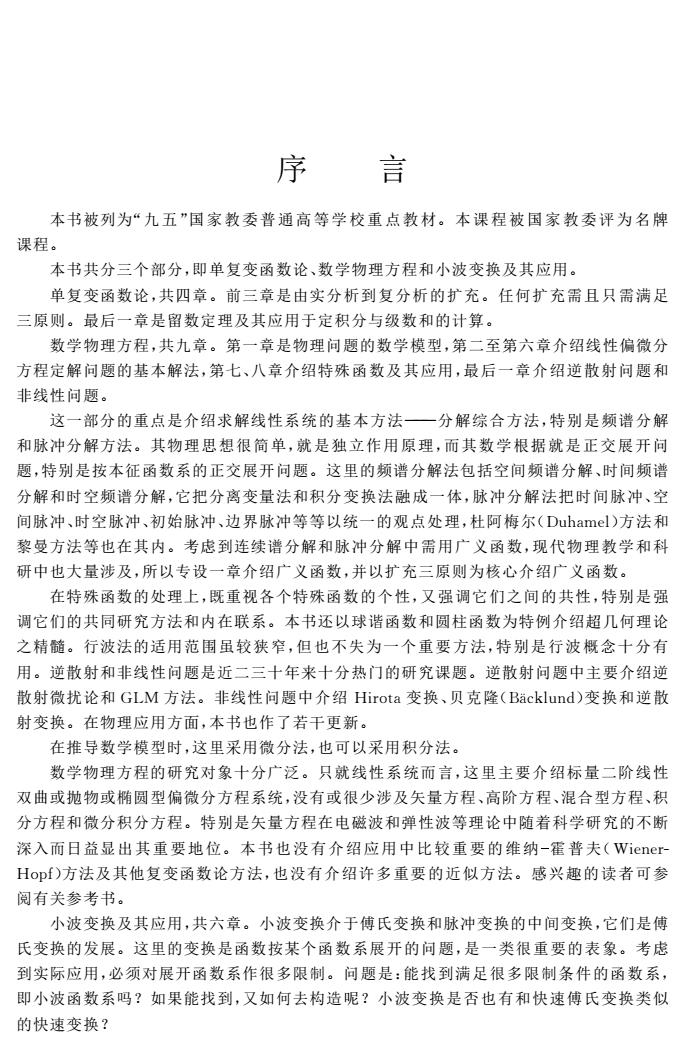
序 言 本书被列为“九五”国家教委普通高等学校重点教材。本课程被国家教委评为名牌 课程。 本书共分三个部分,即单复变函数论、数学物理方程和小波变换及其应用。 单复变函数论,共四章。前三章是由实分析到复分析的扩充。任何扩充需且只需满足 三原则。最后一章是留数定理及其应用于定积分与级数和的计算。 数学物理方程,共九章。第一章是物理问题的数学模型,第二至第六章介绍线性偏微分 方程定解问题的基本解法,第七、八章介绍特殊函数及其应用,最后一章介绍逆散射问题和 非线性问题。 这一部分的重点是介绍求解线性系统的基本方法一分解综合方法,特别是频谱分解 和脉冲分解方法。其物理思想很简单,就是独立作用原理,而其数学根据就是正交展开问 题,特别是按本征函数系的正交展开问题。这里的频谱分解法包括空间频谱分解、时间频谱 分解和时空频谱分解,它把分离变量法和积分变换法融成一体,脉冲分解法把时间脉冲、空 间脉冲、时空脉冲、初始脉冲、边界脉冲等等以统一的观点处理,杜阿梅尔(Duhamel)方法和 黎曼方法等也在其内。考虑到连续谱分解和脉冲分解中需用广义函数,现代物理教学和科 研中也大量涉及,所以专设一章介绍广义函数,并以扩充三原则为核心介绍广义函数。 在特殊函数的处理上,既重视各个特殊函数的个性,又强调它们之间的共性,特别是强 调它们的共同研究方法和内在联系。本书还以球谐函数和圆柱函数为特例介绍超几何理论 之精髓。行波法的适用范围虽较狭窄,但也不失为一个重要方法,特别是行波概念十分有 用。逆散射和非线性问题是近二三十年米十分热门的研究课题。逆散射问题中主要介绍逆 散射微扰论和GLM方法。非线性问题中介绍Hirota变换、贝克隆(Backlund)变换和逆散 射变换。在物理应用方面,本书也作了若干更新。 在推导数学模型时,这里采用微分法,也可以采用积分法。 数学物理方程的研究对象十分广泛。只就线性系统而言,这里主要介绍标量二阶线性 双曲或抛物或椭圆型偏微分方程系统,没有或很少涉及矢量方程、高阶方程、混合型方程、积 分方程和微分积分方程。特别是矢量方程在电磁波和弹性波等理论中随着科学研究的不断 深入而日益显出其重要地位。本书也没有介绍应用中比较重要的维纳-霍普夫(Wiener- HOpf)方法及其他复变函数论方法,也没有介绍许多重要的近似方法。感兴趣的读者可参 阅有关参考书。 小波变换及其应用,共六章。小波变换介于傅氏变换和脉冲变换的中间变换,它们是傅 氏变换的发展。这里的变换是函数按某个函数系展开的问题,是一类很重要的表象。考虑 到实际应用,必须对展开函数系作很多限制。问题是:能找到满足很多限制条件的函数系, 即小波函数系吗?如果能找到,又如何去构造呢?小波变换是否也有和快速傅氏变换类似 的快速变换?
序 言 本书被列为“九 五”国 家 教 委 普 通 高 等 学 校 重 点 教材。本课程被国家教委评为名牌 课程。 本书共分三个部分,即单复变函数论、数学物理方程和小波变换及其应用。 单复变函数论,共四章。前三章是由实分析到复分析的扩充。任何扩充需且只需满足 三原则。最后一章是留数定理及其应用于定积分与级数和的计算。 数学物理方程,共九章。第一章是物理问题的数学模型,第二至第六章介绍线性偏微分 方程定解问题的基本解法,第七、八章介绍特殊函数及其应用,最后一章介绍逆散射问题和 非线性问题。 这一部分的重点是介绍求解线性系统的基本方法———分解综合方法,特别是频谱分解 和脉冲分解方法。其物理思想很简单,就是独立作用原理,而其数学根据就是正交展开问 题,特别是按本征函数系的正交展开问题。这里的频谱分解法包括空间频谱分解、时间频谱 分解和时空频谱分解,它把分离变量法和积分变换法融成一体,脉冲分解法把时间脉冲、空 间脉冲、时空脉冲、初始脉冲、边界脉冲等等以统一的观点处理,杜阿梅尔(Duhamel)方法和 黎曼方法等也在其内。考虑到连续谱分解和脉冲分解中需用广义函数,现代物理教学和科 研中也大量涉及,所以专设一章介绍广义函数,并以扩充三原则为核心介绍广义函数。 在特殊函数的处理上,既重视各个特殊函数的个性,又强调它们之间的共性,特别是强 调它们的共同研究方法和内在联系。本书还以球谐函数和圆柱函数为特例介绍超几何理论 之精髓。行波法的适用范围虽较狭窄,但也不失为一个重要方法,特别是行波概念十分有 用。逆散射和非线性问题是近二三十年来十分热门的研究课题。逆散射问题中主要介绍逆 散射微扰论和 GLM 方法。非线性问题中介绍 Hirota变换、贝克隆(Bcklund)变换和逆散 射变换。在物理应用方面,本书也作了若干更新。 在推导数学模型时,这里采用微分法,也可以采用积分法。 数学物理方程的研究对象十分广泛。只就线性系统而言,这里主要介绍标量二阶线性 双曲或抛物或椭圆型偏微分方程系统,没有或很少涉及矢量方程、高阶方程、混合型方程、积 分方程和微分积分方程。特别是矢量方程在电磁波和弹性波等理论中随着科学研究的不断 深入而日益显出 其 重 要 地 位。本 书 也 没 有 介 绍 应 用 中 比 较 重 要 的 维 纳 霍 普 夫(Wiener Hopf)方法及其他复变函数论方法,也没有介绍许多重要的近似方法。感兴趣的读者可参 阅有关参考书。 小波变换及其应用,共六章。小波变换介于傅氏变换和脉冲变换的中间变换,它们是傅 氏变换的发展。这里的变换是函数按某个函数系展开的问题,是一类很重要的表象。考虑 到实际应用,必须对展开函数系作很多限制。问题是:能找到满足很多限制条件的函数系, 即小波函数系吗?如果能找到,又如何去构造呢?小波变换是否也有和快速傅氏变换类似 的快速变换?
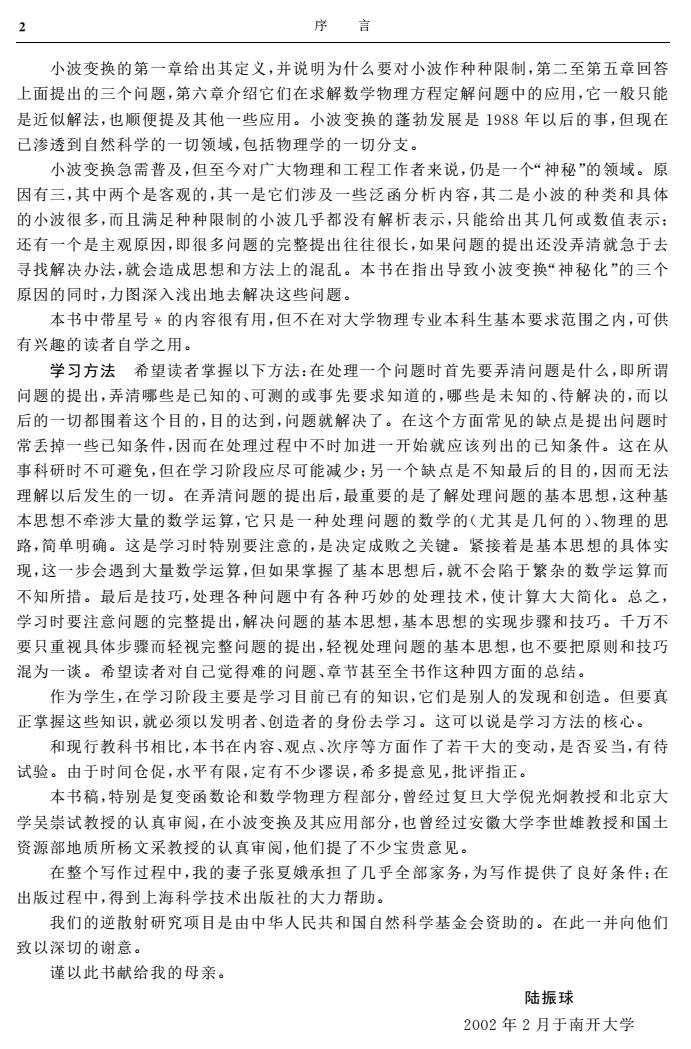
2 序 言 小波变换的第一章给出其定义,并说明为什么要对小波作种种限制,第二至第五章回答 上面提出的三个问题,第六章介绍它们在求解数学物理方程定解问题中的应用,它一般只能 是近似解法,也顺便提及其他一些应用。小波变换的蓬勃发展是1988年以后的事,但现在 已渗透到自然科学的一切领域,包括物理学的一切分支。 小波变换急需普及,但至今对广大物理和工程工作者来说,仍是一个“神秘”的领域。原 因有三,其中两个是客观的,其一是它们涉及一些泛函分析内容,其二是小波的种类和具体 的小波很多,而且满足种种限制的小波几乎都没有解析表示,只能给出其几何或数值表示: 还有一个是主观原因,即很多问题的完整提出往往很长,如果问题的提出还没弄清就急于去 寻找解决办法,就会造成思想和方法上的混乱。本书在指出导致小波变换“神秘化”的三个 原因的同时,力图深入浅出地去解决这些问题。 本书中带星号的内容很有用,但不在对大学物理专业本科生基本要求范围之内,可供 有兴趣的读者自学之用。 学习方法希望读者掌握以下方法:在处理一个问题时首先要弄清问题是什么,即所谓 问题的提出,弄清哪些是已知的、可测的或事先要求知道的,哪些是未知的、待解决的,而以 后的一切都围着这个目的,目的达到,问题就解决了。在这个方面常见的缺点是提出问题时 常丢掉一些已知条件,因而在处理过程中不时加进一开始就应该列出的已知条件。这在从 事科研时不可避免,但在学习阶段应尽可能减少:另一个缺点是不知最后的目的,因而无法 理解以后发生的一切。在弄清问题的提出后,最重要的是了解处理问题的基本思想,这种基 本思想不牵涉大量的数学运算,它只是一种处理问题的数学的(尤其是几何的)、物理的思 路,简单明确。这是学习时特别要注意的,是决定成败之关键。紧接着是基本思想的具体实 现,这一步会遇到大量数学运算,但如果掌握了基本思想后,就不会陷于繁杂的数学运算而 不知所措。最后是技巧,处理各种问题中有各种巧妙的处理技术,使计算大大简化。总之 学习时要注意问题的完整提出,解决问题的基本思想,基本思想的实现步骤和技巧。千万不 要只重视具体步骤而轻视完整问题的提出,轻视处理问题的基本思想,也不要把原则和技巧 混为一谈。希望读者对自己觉得难的问题、章节甚至全书作这种四方面的总结。 作为学生,在学习阶段主要是学习目前已有的知识,它们是别人的发现和创造。但要真 正掌握这些知识,就必须以发明者、创造者的身份去学习。这可以说是学习方法的核心。 和现行教科书相比,本书在内容、观点、次序等方面作了若干大的变动,是否妥当,有待 试验。由于时间仓促,水平有限,定有不少谬误,希多提意见,批评指正。 本书稿,特别是复变函数论和数学物理方程部分,曾经过复旦大学倪光炯教授和北京大 学吴崇试教授的认真审阅,在小波变换及其应用部分,也曾经过安徽大学李世雄教授和国士 资源部地质所杨文采教授的认真审阅,他们提了不少宝贵意见。 在整个写作过程中,我的妻子张夏娥承相了几乎全部家务,为写作提供了良好条件:在 出版过程中,得到上海科学技术出版社的大力帮助。 我们的逆散射研究项目是由中华人民共和国自然科学基金会资助的。在此一并向他们 致以深切的谢意。 谨以此书献给我的母亲 陆振球 2002年2月于南开大学
小波变换的第一章给出其定义,并说明为什么要对小波作种种限制,第二至第五章回答 上面提出的三个问题,第六章介绍它们在求解数学物理方程定解问题中的应用,它一般只能 是近似解法,也顺便提及其他一些应用。小波变换的蓬勃发展是1988年以后的事,但现在 已渗透到自然科学的一切领域,包括物理学的一切分支。 小波变换急需普及,但至今对广大物理和工程工作者来说,仍是一个“神秘”的领域。原 因有三,其中两个是客观的,其一是它们涉及一些泛函分析内容,其二是小波的种类和具体 的小波很多,而且满足种种限制的小波几乎都没有解析表示,只能给出其几何或数值表示; 还有一个是主观原因,即很多问题的完整提出往往很长,如果问题的提出还没弄清就急于去 寻找解决办法,就会造成思想和方法上的混乱。本书在指出导致小波变换“神秘化”的三个 原因的同时,力图深入浅出地去解决这些问题。 本书中带星号的内容很有用,但不在对大学物理专业本科生基本要求范围之内,可供 有兴趣的读者自学之用。 学习方法 希望读者掌握以下方法:在处理一个问题时首先要弄清问题是什么,即所谓 问题的提出,弄清哪些是已知的、可测的或事先要求知道的,哪些是未知的、待解决的,而以 后的一切都围着这个目的,目的达到,问题就解决了。在这个方面常见的缺点是提出问题时 常丢掉一些已知条件,因而在处理过程中不时加进一开始就应该列出的已知条件。这在从 事科研时不可避免,但在学习阶段应尽可能减少;另一个缺点是不知最后的目的,因而无法 理解以后发生的一切。在弄清问题的提出后,最重要的是了解处理问题的基本思想,这种基 本思想不牵涉大量的数学运算,它只是一种处理问题的数学的(尤其是几何的)、物理的思 路,简单明确。这是学习时特别要注意的,是决定成败之关键。紧接着是基本思想的具体实 现,这一步会遇到大量数学运算,但如果掌握了基本思想后,就不会陷于繁杂的数学运算而 不知所措。最后是技巧,处理各种问题中有各种巧妙的处理技术,使计算大大简化。总之, 学习时要注意问题的完整提出,解决问题的基本思想,基本思想的实现步骤和技巧。千万不 要只重视具体步骤而轻视完整问题的提出,轻视处理问题的基本思想,也不要把原则和技巧 混为一谈。希望读者对自己觉得难的问题、章节甚至全书作这种四方面的总结。 作为学生,在学习阶段主要是学习目前已有的知识,它们是别人的发现和创造。但要真 正掌握这些知识,就必须以发明者、创造者的身份去学习。这可以说是学习方法的核心。 和现行教科书相比,本书在内容、观点、次序等方面作了若干大的变动,是否妥当,有待 试验。由于时间仓促,水平有限,定有不少谬误,希多提意见,批评指正。 本书稿,特别是复变函数论和数学物理方程部分,曾经过复旦大学倪光炯教授和北京大 学吴崇试教授的认真审阅,在小波变换及其应用部分,也曾经过安徽大学李世雄教授和国土 资源部地质所杨文采教授的认真审阅,他们提了不少宝贵意见。 在整个写作过程中,我的妻子张夏娥承担了几乎全部家务,为写作提供了良好条件;在 出版过程中,得到上海科学技术出版社的大力帮助。 我们的逆散射研究项目是由中华人民共和国自然科学基金会资助的。在此一并向他们 致以深切的谢意。 谨以此书献给我的母亲。 陆振球 2002年2月于南开大学 2 序 言
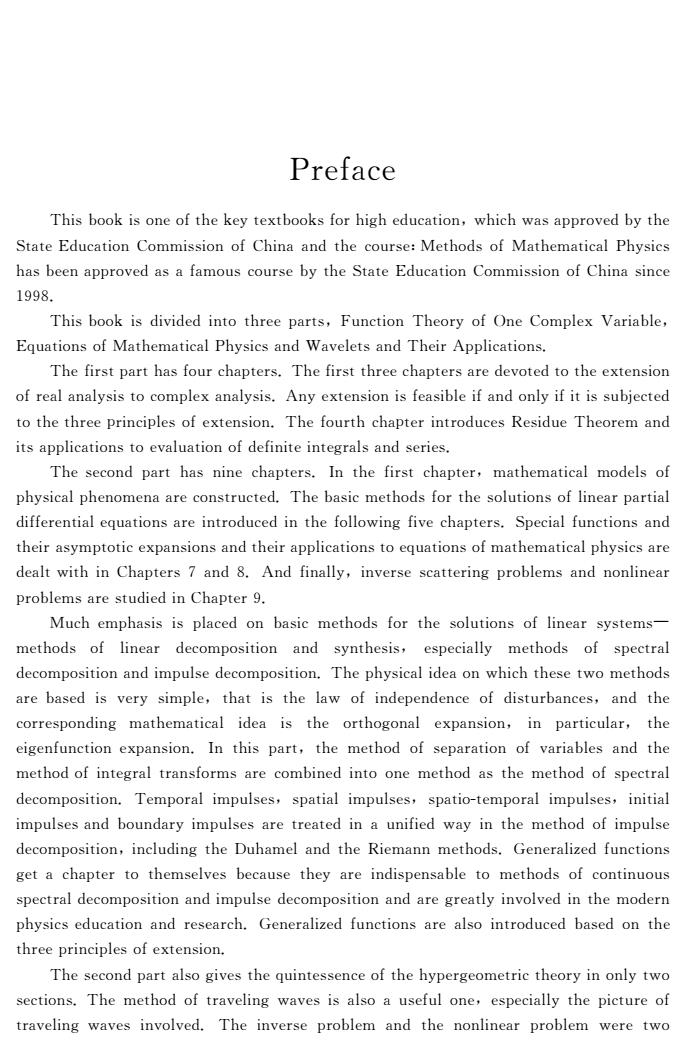
Preface This book is one of the key textbooks for high education,which was approved by the State Education Commission of China and the course:Methods of Mathematical Physics has been approved as a famous course by the State Education Commission of China since 1998. This book is divided into three parts,Function Theory of One Complex Variable, Equations of Mathematical Physics and Wavelets and Their Applications. The first part has four chapters.The first three chapters are devoted to the extension of real analysis to complex analysis.Any extension is feasible if and only if it is subjected to the three principles of extension.The fourth chapter introduces Residue Theorem and its applications to evaluation of definite integrals and series. The second part has nine chapters.In the first chapter,mathematical models of physical phenomena are constructed.The basic methods for the solutions of linear partial differential equations are introduced in the following five chapters.Special functions and their asymptotic expansions and their applications to equations of mathematical physics are dealt with in Chapters 7 and 8.And finally,inverse scattering problems and nonlinear problems are studied in Chapter 9. Much emphasis is placed on basic methods for the solutions of linear systems- methods of linear decomposition and synthesis,especially methods of spectral decomposition and impulse decomposition.The physical idea on which these two methods are based is very simple,that is the law of independence of disturbances,and the corresponding mathematical idea is the orthogonal expansion,in particular,the eigenfunction expansion.In this part,the method of separation of variables and the method of integral transforms are combined into one method as the method of spectral decomposition.Temporal impulses,spatial impulses,spatio-temporal impulses,initial impulses and boundary impulses are treated in a unified way in the method of impulse decomposition,including the Duhamel and the Riemann methods.Generalized functions get a chapter to themselves because they are indispensable to methods of continuous spectral decomposition and impulse decomposition and are greatly involved in the modern physics education and research.Generalized functions are also introduced based on the three principles of extension. The second part also gives the quintessence of the hypergeometric theory in only two sections.The method of traveling waves is also a useful one,especially the picture of traveling waves involved.The inverse problem and the nonlinear problem were two
Preface Thisbookisoneofthekeytextbooksforhigheducation,whichwasapprovedbythe StateEducationCommissionofChinaandthecourse:MethodsofMathematicalPhysics hasbeenapprovedasafamouscoursebytheStateEducationCommissionofChinasince 1998. Thisbookisdividedintothreeparts,Function TheoryofOneComplex Variable, EquationsofMathematicalPhysicsandWaveletsandTheirApplications. Thefirstparthasfourchapters.Thefirstthreechaptersaredevotedtotheextension ofrealanalysistocomplexanalysis.Anyextensionisfeasibleifandonlyifitissubjected tothethreeprinciplesofextension.ThefourthchapterintroducesResidueTheoremand itsapplicationstoevaluationofdefiniteintegralsandseries. Thesecondparthasninechapters.Inthefirstchapter,mathematicalmodelsof physicalphenomenaareconstructed.Thebasicmethodsforthesolutionsoflinearpartial differentialequationsareintroducedinthefollowingfivechapters.Specialfunctionsand theirasymptoticexpansionsandtheirapplicationstoequationsofmathematicalphysicsare dealtwithinChapters7and8.Andfinally,inversescatteringproblemsandnonlinear problemsarestudiedinChapter9. Muchemphasisisplacedon basic methodsforthesolutionsoflinearsystems— methods of linear decomposition and synthesis, especially methods of spectral decompositionandimpulsedecomposition.Thephysicalideaonwhichthesetwomethods arebasedisverysimple,thatisthelaw ofindependenceofdisturbances,andthe corresponding mathematical idea is the orthogonal expansion,in particular,the eigenfunctionexpansion.Inthispart,the methodofseparation ofvariablesandthe methodofintegraltransformsarecombinedintoone methodasthe methodofspectral decomposition.Temporalimpulses,spatialimpulses,spatiotemporalimpulses,initial impulsesandboundaryimpulsesaretreatedinaunified wayinthe methodofimpulse decomposition,includingtheDuhamelandtheRiemann methods.Generalizedfunctions getachaptertothemselvesbecausetheyareindispensableto methodsofcontinuous spectraldecompositionandimpulsedecompositionandaregreatlyinvolvedinthemodern physicseducationandresearch.Generalizedfunctionsarealsointroducedbasedonthe threeprinciplesofextension. Thesecondpartalsogivesthequintessenceofthehypergeometrictheoryinonlytwo sections.The methodoftraveling wavesisalsoausefulone,especiallythepictureof traveling wavesinvolved.Theinverseproblem andthe nonlinearproblem weretwo
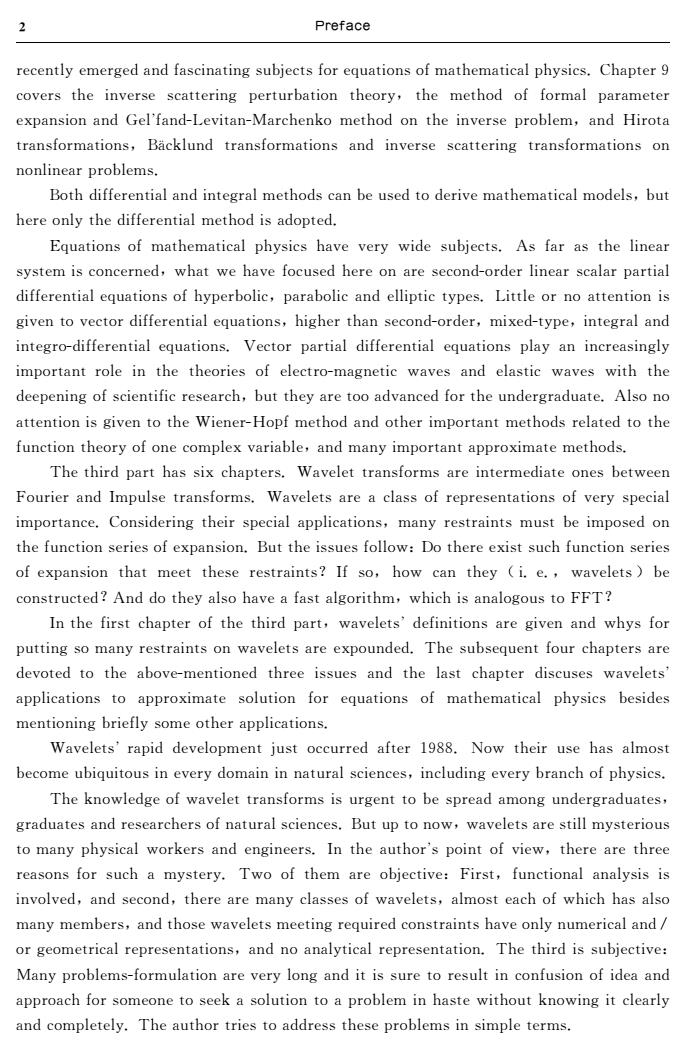
2 Preface recently emerged and fascinating subjects for equations of mathematical physics.Chapter 9 covers the inverse scattering perturbation theory,the method of formal parameter expansion and Gel'fand-Levitan-Marchenko method on the inverse problem,and Hirota transformations,Backlund transformations and inverse scattering transformations on nonlinear problems. Both differential and integral methods can be used to derive mathematical models,but here only the differential method is adopted. Equations of mathematical physics have very wide subjects.As far as the linear system is concerned,what we have focused here on are second-order linear scalar partial differential equations of hyperbolic,parabolic and elliptic types.Little or no attention is given to vector differential equations,higher than second-order,mixed-type,integral and integro-differential equations.Vector partial differential equations play an increasingly important role in the theories of electro-magnetic waves and elastic waves with the deepening of scientific research,but they are too advanced for the undergraduate.Also no attention is given to the Wiener-Hopf method and other important methods related to the function theory of one complex variable,and many important approximate methods. The third part has six chapters.Wavelet transforms are intermediate ones between Fourier and Impulse transforms.Wavelets are a class of representations of very special importance.Considering their special applications,many restraints must be imposed on the function series of expansion.But the issues follow:Do there exist such function series of expansion that meet these restraints?If so,how can they (i.e.,wavelets)be constructed?And do they also have a fast algorithm,which is analogous to FFT? In the first chapter of the third part,wavelets'definitions are given and whys for putting so many restraints on wavelets are expounded.The subsequent four chapters are devoted to the above-mentioned three issues and the last chapter discuses wavelets applications to approximate solution for equations of mathematical physics besides mentioning briefly some other applications. Wavelets'rapid development just occurred after 1988.Now their use has almost become ubiquitous in every domain in natural sciences,including every branch of physics. The knowledge of wavelet transforms is urgent to be spread among undergraduates, graduates and researchers of natural sciences.But up to now,wavelets are still mysterious to many physical workers and engineers.In the author's point of view,there are three reasons for such a mystery.Two of them are objective:First,functional analysis is involved,and second,there are many classes of wavelets,almost each of which has also many members,and those wavelets meeting required constraints have only numerical and/ or geometrical representations,and no analytical representation.The third is subjective: Many problems-formulation are very long and it is sure to result in confusion of idea and pproach for someone to seek a solution to a problem in haste without knowing it clearly and completely.The author tries to address these problems in simple terms
recentlyemergedandfascinatingsubjectsforequationsofmathematicalphysics.Chapter9 coverstheinverse scattering perturbation theory,the method offormal parameter expansionandGelfandLevitanMarchenko methodontheinverseproblem,and Hirota transformations,Bcklund transformations andinverse scattering transformations on nonlinearproblems. Bothdifferentialandintegralmethodscanbeusedtoderivemathematicalmodels,but hereonlythedifferentialmethodisadopted. Equationsof mathematicalphysicshavevery widesubjects.Asfarasthelinear systemisconcerned,whatwehavefocusedhereonaresecondorderlinearscalarpartial differentialequationsofhyperbolic,parabolicandelliptictypes.Littleornoattentionis giventovectordifferentialequations,higherthansecondorder,mixedtype,integraland integrodifferentialequations.Vectorpartialdifferentialequationsplayanincreasingly importantroleinthetheoriesofelectromagnetic wavesand elastic waves withthe deepeningofscientificresearch,buttheyaretooadvancedfortheundergraduate.Alsono attentionisgiventotheWienerHopfmethodandotherimportantmethodsrelatedtothe functiontheoryofonecomplexvariable,andmanyimportantapproximatemethods. Thethirdparthassixchapters.Wavelettransformsareintermediateonesbetween FourierandImpulsetransforms.Waveletsareaclassofrepresentationsofveryspecial importance.Consideringtheirspecialapplications,manyrestraintsmustbeimposedon thefunctionseriesofexpansion.Buttheissuesfollow:Dothereexistsuchfunctionseries ofexpansionthat meettheserestraints?Ifso,how canthey(i.e.,wavelets)be constructed?Anddotheyalsohaveafastalgorithm,whichisanalogoustoFFT? Inthefirstchapterofthethirdpart,waveletsdefinitionsaregivenand whysfor puttingsomanyrestraintsonwaveletsareexpounded.Thesubsequentfourchaptersare devotedtotheabovementionedthreeissuesandthelastchapterdiscuses wavelets applicationsto approximate solution for equations of mathematical physics besides mentioningbrieflysomeotherapplications. Waveletsrapiddevelopmentjustoccurredafter1988.Now theirusehasalmost becomeubiquitousineverydomaininnaturalsciences,includingeverybranchofphysics. Theknowledgeofwavelettransformsisurgenttobespreadamongundergraduates, graduatesandresearchersofnaturalsciences.Butuptonow,waveletsarestillmysterious tomanyphysicalworkersandengineers.Intheauthorspointofview,therearethree reasonsforsucha mystery.Twoofthem areobjective:First,functionalanalysisis involved,andsecond,therearemanyclassesofwavelets,almosteachofwhichhasalso manymembers,andthosewaveletsmeetingrequiredconstraintshaveonlynumericaland/ orgeometricalrepresentations,andnoanalyticalrepresentation.Thethirdissubjective: Manyproblemsformulationareverylonganditissuretoresultinconfusionofideaand approachforsomeonetoseekasolutiontoaprobleminhastewithoutknowingitclearly andcompletely.Theauthortriestoaddresstheseproblemsinsimpleterms. 2 犘狉犲犳犪犮犲

Preface 3 The parts asterisked are not required,but recommended for undergraduates majoring in physics. Methods of Study In tackling a problem,you must know what the problem is,i.e.,problem-formation, it means that you must gain a clear idea of the problem:which are known,measurable or required to be given and which are unknown and to be sought,on that the subsequent proceedings are centered.But you can find out that problem-formation is often hazy and incomplete somewhere else.One example is,some known conditions are not presented at the very start and they are picked up now and then when they are needed in solving the problem.Such a practice is unavoidable in scientific research but it is surely not good for students'studying and should be given up in any textbook.The other is,sometimes in solving a problem,one is unaware of what he wants to reach after and hence he does not understand what will happen afterwards.After clear and complete problem-formation,it is most important to grasp the basic ideas of solving the problem,which are only mathematical (especially geometrical)or physical thoughts,simple and clear,and in which not a great amount of mathematical calculations are involved.To grasp the basic ideas is the key to solving a problem that must be paid great attention to.And then it is followed by the implementation of the basic ideas,in which generally a great amount of mathematical calculations are involved.You will never get boggled down in any tedious calculations if you know the basic ideas well.The final step is to use some tricks to simplify and reduce calculations. In brief,in our studying,we must pay attention to complete problem-formation,the basic ideas of solving the problem,the implementation of such basic ideas and the tricks in the implementation.We must under no circumstances concentrate on mathematical calculations only,must devote great attention to complete problem-formation and the basic ideas of solving the problem and but we do not confuse principles with tricks.The author suggests that readers make a summary on some problems or some chapters and sections, even a whole part,which they feel difficult to understand,according to the four-point method of study. What a student studies is existing knowledge that was discovered and created by somebody else.But if you have a good command of it you must study as if you were an inventor and creator,that is the core of a good method of study. In comparison with existing textbooks on methods of mathematical physics,some big changes in contents,viewpoints and order have been made in this book.Any suggestions, comments and criticisms are welcome for further improvement to this book. The manuscript of this book,especially,of the first two parts,was reviewed by Professor Ni Guangjioing in Fudan University and Professor Wu Chongshi in Beijing University,and the manuscript of the third part was reviewed by Professor Yang Wenchai in the Institute of Geology,the Ministry of Land and Resources of People's Republic of
Thepartsasteriskedarenotrequired,butrecommendedforundergraduatesmajoring inphysics. MethodsofStudy Intacklingaproblem,youmustknowwhattheproblemis,i.e.,problemformation, itmeansthatyoumustgainaclearideaoftheproblem:whichareknown,measurableor requiredtobegivenandwhichareunknownandtobesought,onthatthesubsequent proceedingsarecentered.Butyoucanfindoutthatproblemformationisoftenhazyand incompletesomewhereelse.Oneexampleis,someknownconditionsarenotpresentedat theverystartandtheyarepickedupnowandthenwhentheyareneededinsolvingthe problem.Suchapracticeisunavoidableinscientificresearchbutitissurelynotgoodfor studentsstudyingandshouldbegivenupinanytextbook.Theotheris,sometimesin solvingaproblem,oneisunawareofwhathewantstoreachafterandhencehedoesnot understandwhatwillhappenafterwards.Afterclearandcompleteproblemformation,it is mostimportantto graspthe basicideasofsolvingthe problem,which are only mathematical(especiallygeometrical)orphysicalthoughts,simpleandclear,andinwhich notagreatamountofmathematicalcalculationsareinvolved.Tograspthebasicideasis thekeytosolvingaproblemthatmustbepaidgreatattentionto.Andthenitisfollowed bytheimplementation ofthe basicideas,in which generally a great amount of mathematicalcalculationsareinvolved.Youwillnevergetboggleddowninanytedious calculationsifyouknowthebasicideas well.Thefinalstepistousesometricksto simplifyandreducecalculations. Inbrief,inourstudying,wemustpayattentiontocompleteproblemformation,the basicideasofsolvingtheproblem,theimplementationofsuchbasicideasandthetricksin theimplementation. We must under no circumstances concentrate on mathematical calculationsonly,mustdevotegreatattentiontocompleteproblemformationandthebasic ideasofsolvingtheproblemandbutwedonotconfuseprincipleswithtricks.Theauthor suggeststhatreadersmakeasummaryonsomeproblemsorsomechaptersandsections, evenawholepart,whichtheyfeeldifficulttounderstand,accordingtothefourpoint methodofstudy. Whatastudentstudiesisexistingknowledgethatwasdiscoveredandcreatedby somebodyelse.Butifyouhaveagoodcommandofityoumuststudyasifyouwerean inventorandcreator,thatisthecoreofagoodmethodofstudy. Incomparisonwithexistingtextbooksonmethodsofmathematicalphysics,somebig changesincontents,viewpointsandorderhavebeenmadeinthisbook.Anysuggestions, commentsandcriticismsarewelcomeforfurtherimprovementtothisbook. Themanuscriptofthisbook,especially,ofthefirsttwoparts,wasreviewedby ProfessorNiGuangjioingin Fudan Universityand Professor Wu Chongshiin Beijing University,andthemanuscriptofthethirdpartwasreviewedbyProfessorYangWenchai intheInstituteofGeology,theMinistryofLandandResourcesofPeoplesRepublicof 犘狉犲犳犪犮犲 3
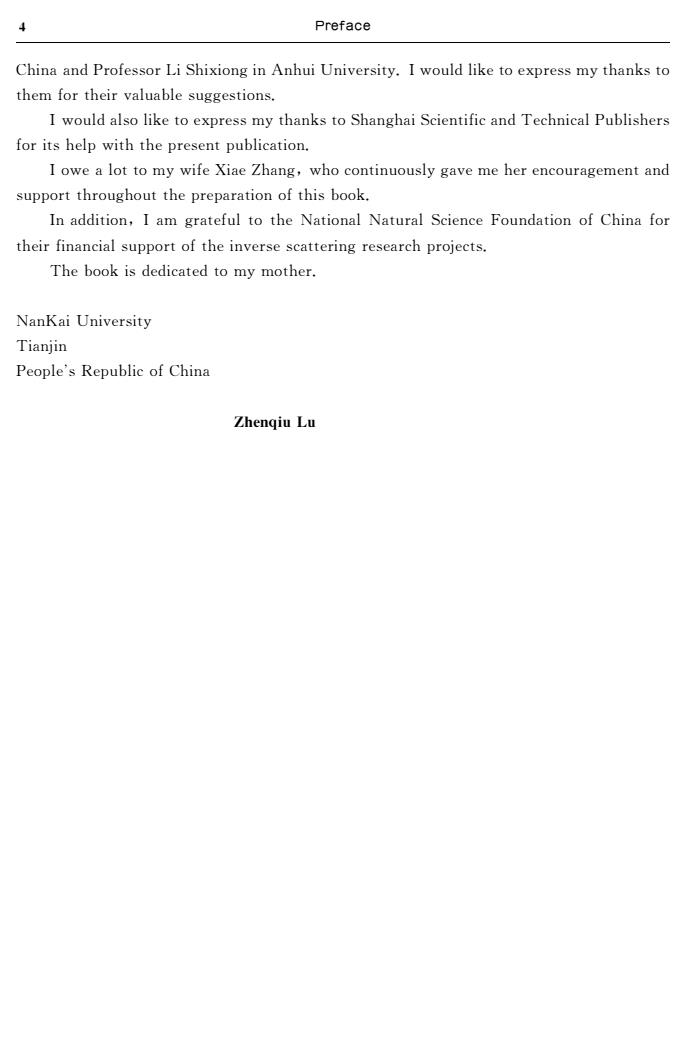
Preface China and Professor Li Shixiong in Anhui University.I would like to express my thanks to them for their valuable suggestions. I would also like to express my thanks to Shanghai Scientific and Technical Publishers for its help with the present publication. I owe a lot to my wife Xiae Zhang,who continuously gave me her encouragement and support throughout the preparation of this book. In addition,I am grateful to the National Natural Science Foundation of China for their financial support of the inverse scattering research projects. The book is dedicated to my mother. NanKai University Tianjin People's Republic of China Zhengiu Lu
ChinaandProfessorLiShixionginAnhuiUniversity.Iwouldliketoexpressmythanksto themfortheirvaluablesuggestions. IwouldalsoliketoexpressmythankstoShanghaiScientificandTechnicalPublishers foritshelpwiththepresentpublication. IowealottomywifeXiaeZhang,whocontinuouslygavemeherencouragementand supportthroughoutthepreparationofthisbook. Inaddition,Iam gratefultotheNationalNaturalScienceFoundationofChinafor theirfinancialsupportoftheinversescatteringresearchprojects. Thebookisdedicatedtomymother. NanKaiUniversity Tianjin PeoplesRepublicofChina ZhenqiuLu 4 犘狉犲犳犪犮犲
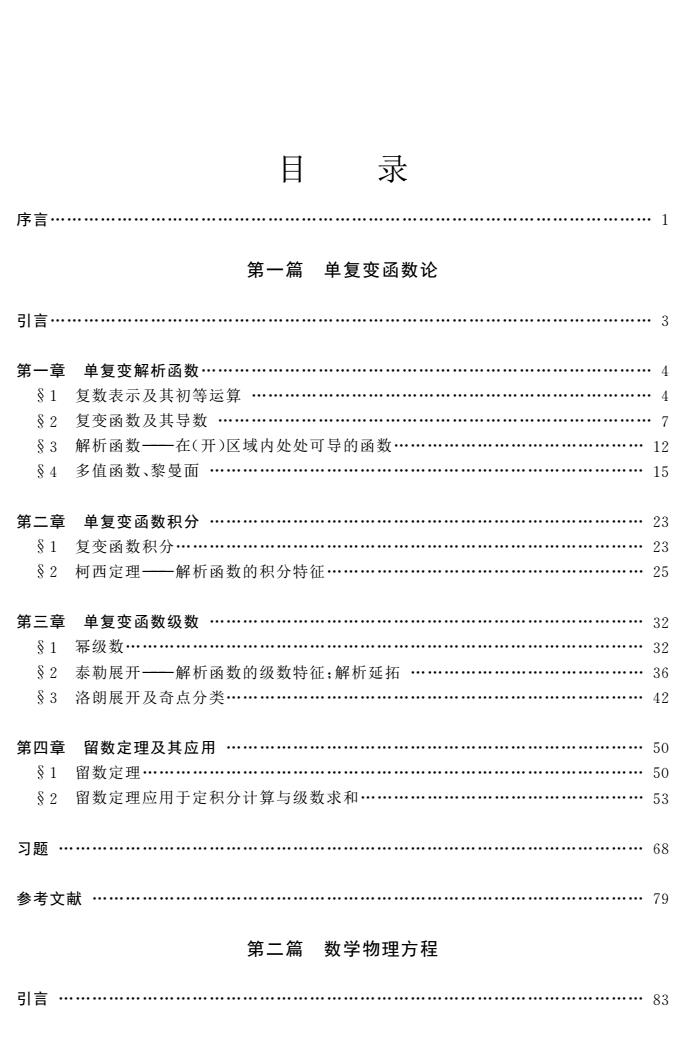
目 录 序言 第一篇单复变函数论 引言… 第一章单复变解析函数……4 §1复数表示及其初等运算 00带4中04”5中00+中40:甲年05”…” §2复变函数及其导数……………………7 83解析函数 一在(开)区域内处处可导的函数………12 S4多值函数、黎曼面… 15 第二章单复变函数积分 §1复变函数积分………… 23 S2柯西定理一解析函数的积分特征… 25 第三章单复变函数级数 32 1幂级数……………32 §2泰勒展开一解析函数的级数特征:解析延拓…………36 §3洛朗展开及奇点分类……42 第四章留数定理及其应用 50 1留数定理 50 §2留数定理应用于定积分计算与级数求和… 习题……… 68 参考文…79 第二篇数学物理方程 引言 83
目 录 序言……………………………………………………………………………………………… 1 第一篇 单复变函数论 引言……………………………………………………………………………………………… 3 第一章 单复变解析函数……………………………………………………………………… 4 §1 复数表示及其初等运算 ……………………………………………………………… 4 §2 复变函数及其导数 …………………………………………………………………… 7 §3 解析函数———在(开)区域内处处可导的函数……………………………………… 12 §4 多值函数、黎曼面 …………………………………………………………………… 15 第二章 单复变函数积分 …………………………………………………………………… 23 §1 复变函数积分………………………………………………………………………… 23 §2 柯西定理———解析函数的积分特征………………………………………………… 25 第三章 单复变函数级数 …………………………………………………………………… 32 §1 幂级数………………………………………………………………………………… 32 §2 泰勒展开———解析函数的级数特征;解析延拓 …………………………………… 36 §3 洛朗展开及奇点分类………………………………………………………………… 42 第四章 留数定理及其应用 ………………………………………………………………… 50 §1 留数定理……………………………………………………………………………… 50 §2 留数定理应用于定积分计算与级数求和…………………………………………… 53 习题 …………………………………………………………………………………………… 68 参考文献 ……………………………………………………………………………………… 79 第二篇 数学物理方程 引言 …………………………………………………………………………………………… 83
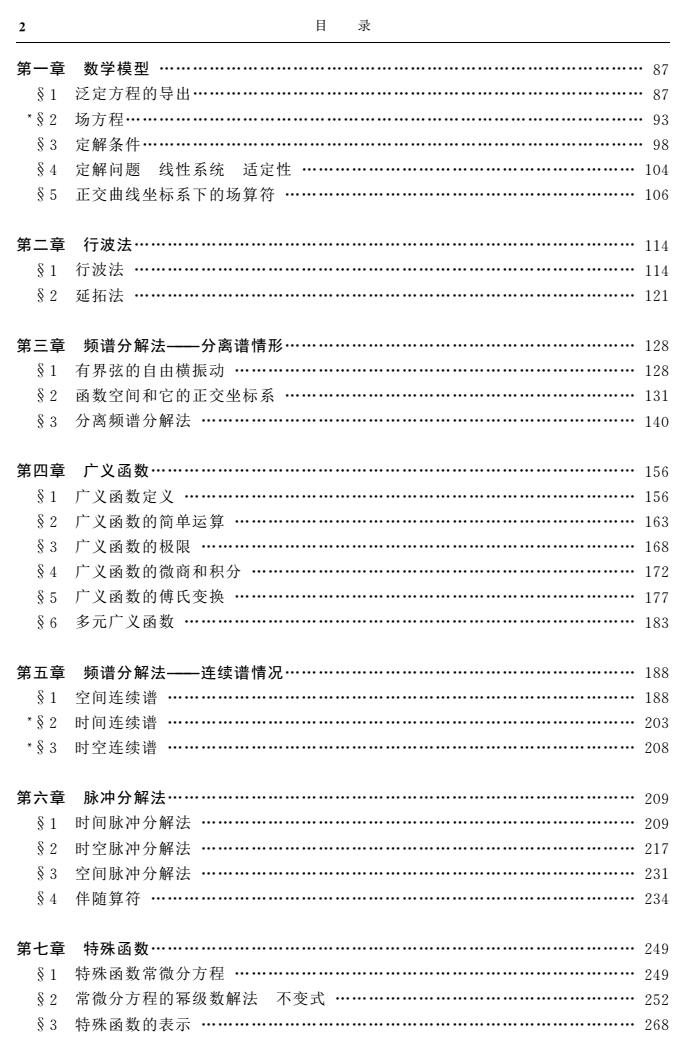
2 录 第一章数学模型……… …87 1泛定方程的导出………87 S2场方程………………93 §3定解条件………98 §4定解问题线性系统适定性 … 104 5正交曲线坐标系下的场算符………… 106 第二章行波法…114 S1行波法… 114 2延拓法 …… 121 第三章频谱分解法一 —分离谱情形…128 §1有界弦的自由横振动………128 82函数空间和它的正交坐标系 131 §3分离频谱分解法… 140 第四章广义函数……… 156 §1广义函数定义………………… 156 §2广义函数的简单运算………………… 163 §3广义函数的极限… 168 §4广义函数的微商和积分 172 5广义函数的傅氏变换… 177 6多元广义函数… 183 第五章频谱分解法一连续谱情况 188 §1空间连续谱 188 2时间连续谱… 203 §3时空连续谱…………208 第六章脉冲分解法… 209 §1时间脉冲分解法 209 §2时空脉冲分解法 217 §3空间脉冲分解法 231 84伴随算符… 234 第七章特殊函数……………249 §】特殊函数常微分方程…249 S2常微分方程的幂级数解法不变式……252 §3特殊函数的表示……268
第一章 数学模型 …………………………………………………………………………… 87 §1 泛定方程的导出……………………………………………………………………… 87 §2 场方程………………………………………………………………………………… 93 §3 定解条件……………………………………………………………………………… 98 §4 定解问题 线性系统 适定性 …………………………………………………… 104 §5 正交曲线坐标系下的场算符 ……………………………………………………… 106 第二章 行波法……………………………………………………………………………… 114 §1 行波法 ……………………………………………………………………………… 114 §2 延拓法 ……………………………………………………………………………… 121 第三章 频谱分解法———分离谱情形……………………………………………………… 128 §1 有界弦的自由横振动 ……………………………………………………………… 128 §2 函数空间和它的正交坐标系 ……………………………………………………… 131 §3 分离频谱分解法 …………………………………………………………………… 140 第四章 广义函数…………………………………………………………………………… 156 §1 广义函数定义 ……………………………………………………………………… 156 §2 广义函数的简单运算 ……………………………………………………………… 163 §3 广义函数的极限 …………………………………………………………………… 168 §4 广义函数的微商和积分 …………………………………………………………… 172 §5 广义函数的傅氏变换 ……………………………………………………………… 177 §6 多元广义函数 ……………………………………………………………………… 183 第五章 频谱分解法———连续谱情况……………………………………………………… 188 §1 空间连续谱 ………………………………………………………………………… 188 §2 时间连续谱 ………………………………………………………………………… 203 §3 时空连续谱 ………………………………………………………………………… 208 第六章 脉冲分解法………………………………………………………………………… 209 §1 时间脉冲分解法 …………………………………………………………………… 209 §2 时空脉冲分解法 …………………………………………………………………… 217 §3 空间脉冲分解法 …………………………………………………………………… 231 §4 伴随算符 …………………………………………………………………………… 234 第七章 特殊函数…………………………………………………………………………… 249 §1 特殊函数常微分方程 ……………………………………………………………… 249 §2 常微分方程的幂级数解法 不变式 ……………………………………………… 252 §3 特殊函数的表示 …………………………………………………………………… 268 2 目 录